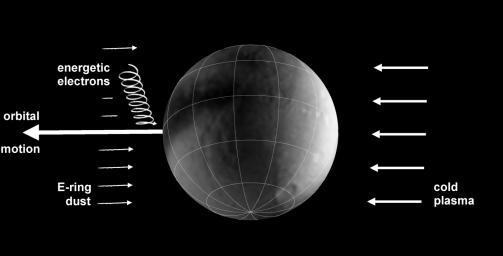This schematic graphic illustrates the bombardments that lead to colorful splotches and bands on the surfaces of several icy moons of Saturn. The arrow indicating the orbital motion of the moon is the direction of the moon's path around Saturn. Icy material sprayed by the moon Enceladus makes up the E ring dust that hits several moons head-on in their orbit around Saturn. E ring dust tints the leading hemisphere of Tethys, Dione and Rhea with a coral-colored frost. When the spray falls back on Enceladus, it leaves a bluish frost.
The trailing hemispheres of several moons are thought to be struck by circulating plasma, a gas-like state of matter so hot that atoms split into an ion and an electron, in Saturn's magnetic environment. The trailing hemispheres of Tethys, Dione and Rhea have a darker, rust-colored reddish hue. Tiny, iron-rich "nanoparticles" may also be involved in painting the trailing hemispheres a reddish color.
The drift of high-energy electrons in a direction opposite to the flow of plasma in the magnetic bubble around Saturn appears to influence the color pattern on Mimas and Tethys. Scientists are still figuring out exactly what is happening, but the electrons appear to be zapping the Mimas surface in a way that matches the Pac-Man thermal pattern detected by Cassini's composite infrared spectrometer early in 2010.
Although there are similarities among the satellites, there area also a few differences. While plasma bombardment is important on all the moons, the electrons flowing in the opposite direction are dominant only between Mimas and Tethys (Enceladus is protected by its E-ring shroud). E-ring material coats the leading hemispheres of most of the satellites, but in fact hits the trailing side on Mimas.
The Cassini-Huygens mission is a cooperative project of NASA, the European Space Agency and the Italian Space Agency. The Jet Propulsion Laboratory, a division of the California Institute of Technology in Pasadena, manages the mission for NASA's Science Mission Directorate in Washington. The Cassini orbiter and its two onboard cameras were designed, developed and assembled at JPL. The imaging team is based at the Space Science Institute, Boulder, Colo.
For more information about the Cassini-Huygens mission visit http://www.nasa.gov/cassini and http://saturn.jpl.nasa.gov .

 Planetary Data System
Planetary Data System












